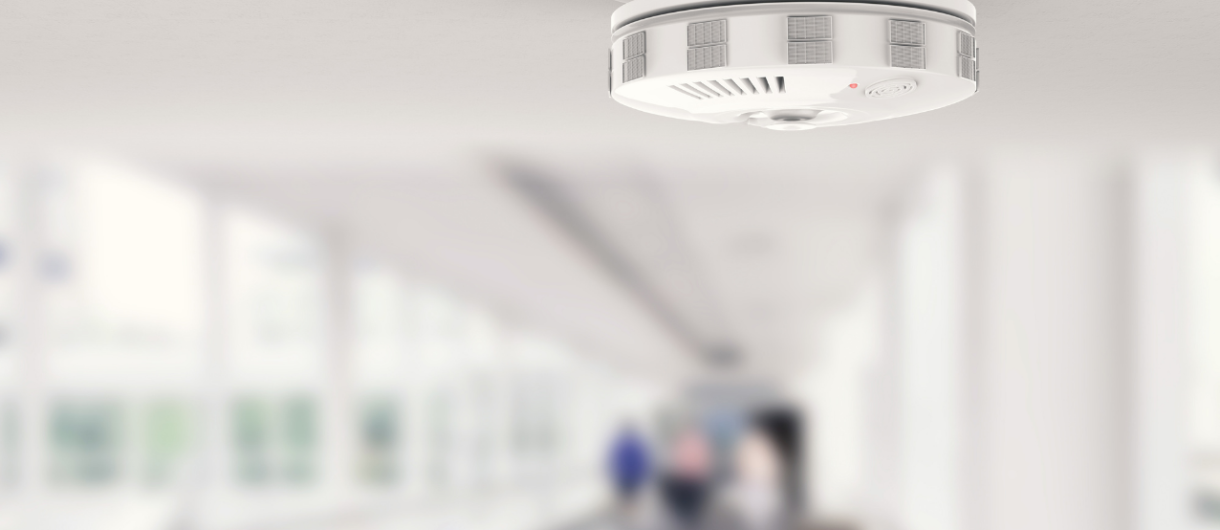
Smoke detectors: types, regulations and their role with smoke curtains
In any fire protection strategy, early detection is the first link in a critical chain that can mean the difference between an effective evacuation and a catastrophic scenario. Smoke detectors, as early activation devices, play a key role not only in safeguarding human lives but also in ensuring the operational efficiency of other integrated systems, such as smoke control barriers.
What will you learn in this article?
- The types of smoke detectors and how they work: we’ll explore in detail the optical and ionization models.
- The functional relationship between smoke detectors and smoke control curtains.
What types of smoke detectors can we find on the market today?
The current fire protection market offers a wide range of detection systems, each specialized in identifying different indicators of a potential fire. These include heat detectors, which react to temperature increases; gas detectors, which identify the presence of combustible or toxic gases; and flame detectors, which detect infrared or ultraviolet radiation emitted by fire.
However, this article focuses on smoke detectors, which are critical for early detection in most industrial and commercial environments. These systems are designed to continuously monitor the air in a protected space, identifying particles generated by combustion and pyrolysis. Upon detecting these particles, they trigger an acoustic and/or visual alarm, alerting occupants to a potential fire at its earliest stage—thus enabling rapid activation of emergency protocols and automated fire protection systems.
Thanks to technological advancements, smoke detectors have evolved considerably. Two main technologies stand out for their sensitivity to combustion particles: ionization detectors and optical (photoelectric) detectors. Each has specific features and applications, which we’ll examine below.
Ionic smoke detectors
These detectors are designed to identify very small particles, nearly invisible to the naked eye. How do they work? Through the principle of air ionization.
An ionization detector includes two plates and a radioactive material that ionizes the air flowing between them. This ionized air creates a very low electrical current. When smoke particles enter the chamber, ionization is reduced, disrupting the current and triggering the alarm.
Due to their sensitivity and quick response time, they are especially recommended in chemical industries, where fire can spread rapidly due to the materials stored on site.
Optical smoke detectors
Also known as photoelectric detectors, these devices are designed to detect smoke from slow-burning or low-intensity fires.
They include a light emitter and a photosensitive receptor. The system works by projecting a light beam continuously onto the photodiode. When smoke particles are present, the light is scattered, which is detected by the sensor, automatically triggering a sound alarm.
These systems are often installed in air extraction ducts (ventilation systems) to detect smoke in large spaces. They are commonly used in shopping centers, supermarkets, and warehouses.
What benefits can these detection systems provide?
Although smoke detectors do not directly activate textile fire curtains, their role within the integrated fire protection system is critical. Upon detecting combustion particles, the detectors send a signal to the fire alarm control panel, which then processes the event and issues commands to connected systems—including the Tecnitex curtain control panel.
From that control panel, the automatic deployment of fire or smoke curtains is managed, in accordance with the building’s predefined fire safety protocol. This chain of communication ensures coordinated response for fire containment and smoke channeling, without requiring a direct connection between detector and curtain.
It is essential to emphasize that an efficient system design must begin with a thorough analysis of the installation’s specific characteristics: architecture, use, inherent risks, and operating conditions. This technical evaluation helps define the optimal combination of detectors and textile barriers, ensuring a protection plan that maximizes safety and operational continuity.
For projects requiring technical consultancy in the design of smoke control and compartmentation systems using textile solutions, Tecnitex offers specialized engineering support. Our team of experts works closely with architectural firms, project managers, and site engineers to define and implement customized barrier systems. All our solutions are fully aligned with current regulations and the highest technical standards in the field of passive fire protection.
Discover more about our consulting service here: Fire Protection Consultancy